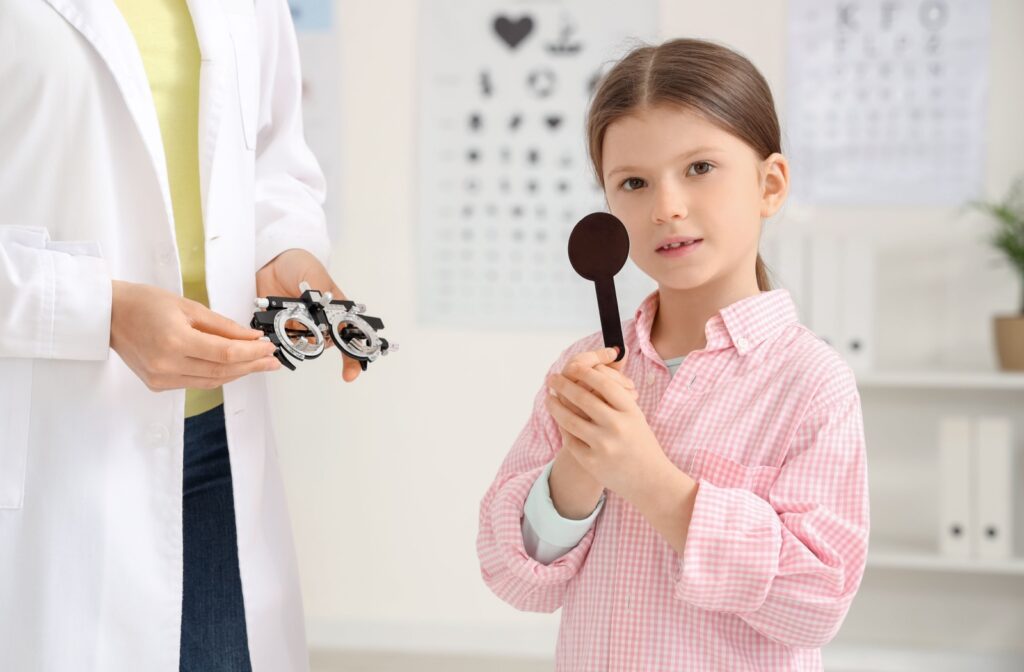Myopia, commonly known as nearsightedness, is one of the most widespread vision concerns among school-aged children. While glasses or contact lenses can provide clear vision, they don’t prevent the condition from worsening over time. That’s where myopia control lenses come in.
Myopia control lenses work by correcting blurred vision while gently defocusing peripheral vision, which helps signal the eye to slow down its growth. The dual-action design helps reduce how quickly a child’s prescription worsens and supports long-term eye health.
By managing how the eye grows, myopia control lenses can help improve day-to-day vision and help limit the long-term risks associated with high myopia.
What Is Myopia?
Myopia is a refractive error that makes distant objects appear blurry while close-up objects remain clear. The condition occurs when the eyeball grows too long, or the cornea has too much curvature, causing light to focus in front of the retina rather than directly on it.
As a result, seeing things like signs, screens, or classroom boards from a distance becomes challenging. While myopia can be managed and its progression slowed, there is currently no cure—meaning once it develops, it tends to persist into adulthood.
Who Is at Risk?
Myopia typically develops in childhood, between ages 6 and 14, often worsening until the early 20s.
Genetics plays a significant role—if one or both parents are nearsighted, a child has a high chance of developing nearsightedness.
Environmental factors also contribute. Kids who spend a lot of time doing close-up activities like reading or screen use and not enough time outdoors are more prone to developing myopia.
Why Slowing Myopia Matters
Managing myopia is about more than just improving day-to-day vision—it’s about safeguarding long-term eye health.
When myopia progresses without intervention, the eye continues to elongate, increasing the risk of serious eye conditions such as retinal detachment, glaucoma, macular degeneration, and vision loss later in life.
The Long-Term Risks of High Myopia
Children with high myopia (a prescription stronger than -6.00 dioptres) are especially vulnerable to these risks. The good news is that taking action early to slow myopia progression can help prevent a more severe form of the condition and support healthy vision into adulthood.
How Myopia Control Lenses Work
Unlike traditional single-vision lenses, which only correct blurry vision, myopia control lenses are designed to influence how the eye grows.
These lenses use a technique called peripheral defocus. The idea is to send the right visual signals to the eye’s periphery to help slow its elongation.
By preventing the signal that triggers further eye growth, the technique can help reduce how quickly a child’s prescription increases year over year.
Central Correction & Peripheral Treatment
Myopia control lenses correct central vision like regular lenses, helping kids see clearly. But they also subtly alter how light hits the peripheral retina, helping “train” the eye to slow its growth. The dual-action design is what helps make them effective.
Types of Myopia Control Lenses
Several types of myopia control treatments are available, each taking a slightly different approach to slowing the progression of nearsightedness. The most suitable option will depend on your child’s age, prescription, lifestyle, and ability to manage the treatment independently.
Understanding the differences between these options can help you feel more confident in your decision when working with your child’s optometrist to develop a care plan.
Multifocal Contact Lenses
Multifocal soft contact lenses are worn daily and contain multiple prescription zones. They work similarly to bifocals, which have 2 distinct prescription zones to help correct blurriness near and far.
The zones in myopia control lenses work together to correct central vision while redirecting how light focuses on the outer edges of your retina, which helps signal the eye to slow its growth.
Multifocal lenses can be a good fit for kids who can follow a daily lens care routine and are comfortable wearing contact lenses.
MiSight 1 Day Contact Lenses
MiSight 1 day lenses are daily disposable soft contact lenses designed explicitly for myopia control in children. With a proven track record in clinical studies, these lenses can correct vision and help slow myopia progression when worn consistently.
MiSight lenses offer the added convenience of a fresh, clean lens each day, making them easier for young wearers.
Orthokeratology (Ortho-K) Lenses
Ortho-k lenses are worn overnight to gently reshape the cornea as your child sleeps. Once removed in the morning, they can provide clear vision throughout the day—no need for glasses or daytime contacts.
Ortho-k treatment can benefit active kids or those involved in sports who prefer to go without corrective lenses during the day.

Myopia Control Eyeglass Lenses
Myopia control glasses are a comfortable and familiar option for kids who may not be ready for contact lenses.
Lenses such as ZEISS myopia management lenses like MyoVision, MyoCare, and MyopiLux feature bifocal or progressive-style zones that help reduce eye strain and manage peripheral focus to help effectively slow myopia progression.
Myopia control glasses look and feel like regular glasses but deliver targeted treatment for developing eyes.
How Effective Are They?
Research shows that myopia control lenses can reduce the progression of nearsightedness by up to 60% or more, depending on the lens type and how consistently they’re worn.
What the Science Says
Clinical studies have found that children who use myopia control methods—especially when started early—tend to experience significantly less vision decline over time. For example, a 3-year MyopiLux Max study found that kids experienced significantly less progression than kids who wore regular single-vision lenses.
Are They Safe for Children?
Yes, myopia control lenses are safe, and many are developed for kids with their unique needs in mind. As with any vision treatment, proper fit and regular monitoring are key. Children generally adapt well to these lenses with training and support.
Alternative Management Options
Low-dose atropine is a medicated eye drop used at bedtime to help slow the elongation of the eye, a key factor in myopia progression.
Although atropine is commonly used during comprehensive eye exams to dilate the pupil, low-dose concentrations can effectively manage myopia in kids with minimal side effects.
However, atropine eye drops don’t correct blurred vision, so your eye doctor would likely prescribe them alongside standard corrective lenses or specialized myopia control lenses.
What to Expect from a Myopia Control Exam
If your child is experiencing blurry vision or their prescription keeps increasing, a comprehensive eye exam is the first step.
During the exam, an optometrist will measure eye length, assess vision changes, and determine if your child is a good candidate for myopia control. From there, they’ll recommend a tailored approach and set up follow-up appointments to track progress.
Ongoing Monitoring
Regular visits, usually every 6 months, allow your optometrist to adjust and evaluate treatment effectiveness as needed. Myopia management is a long-term process. That’s why consistent care is essential for effective results.
Small Lifestyle Changes Can Help, Too
In addition to lens-based treatments, lifestyle changes can salessupport healthy vision development.
Encouraging your child to spend more time outdoors, at least 90 minutes per day, has been shown to help reduce the onset and progression of myopia. Limiting screen time and taking breaks during near work (like reading) can also make a difference.
Get Personalized Support & Management for Your Kid’s Vision
Slowing myopia in its early stages can make a difference in your child’s future eye health. With a personalized combination of tools, support, and regular monitoring, you can help your child enjoy clearer vision and reduce their risk of long-term complications.
At Advance Eye Care Center in Regina, we offer specialized myopia control services tailored to your child’s unique needs. Our welcoming, knowledgeable team is here to guide you through every step of the process. Book your child’s myopia consultation today.





